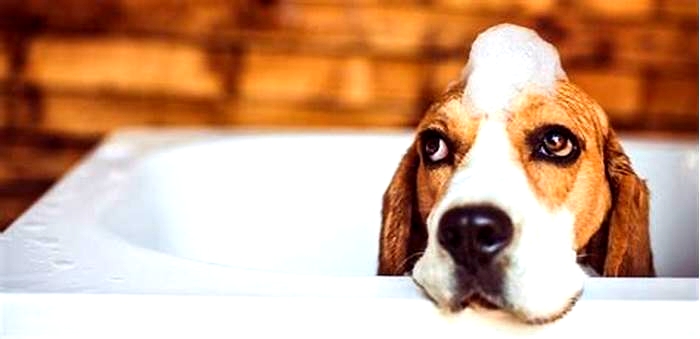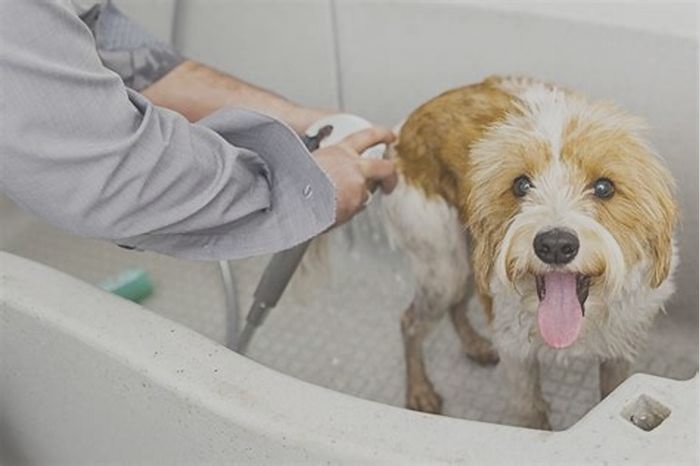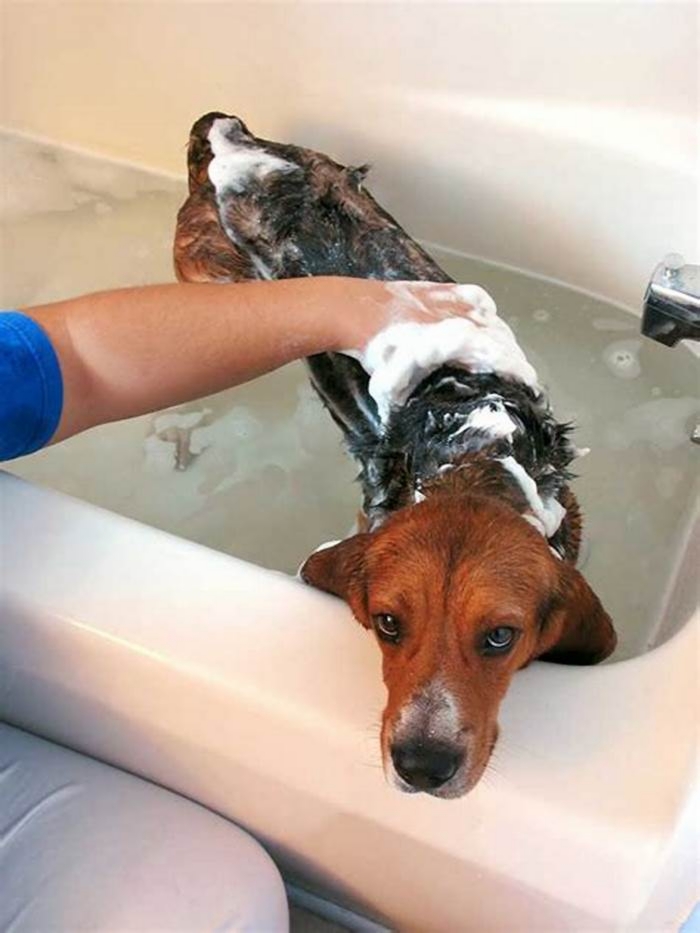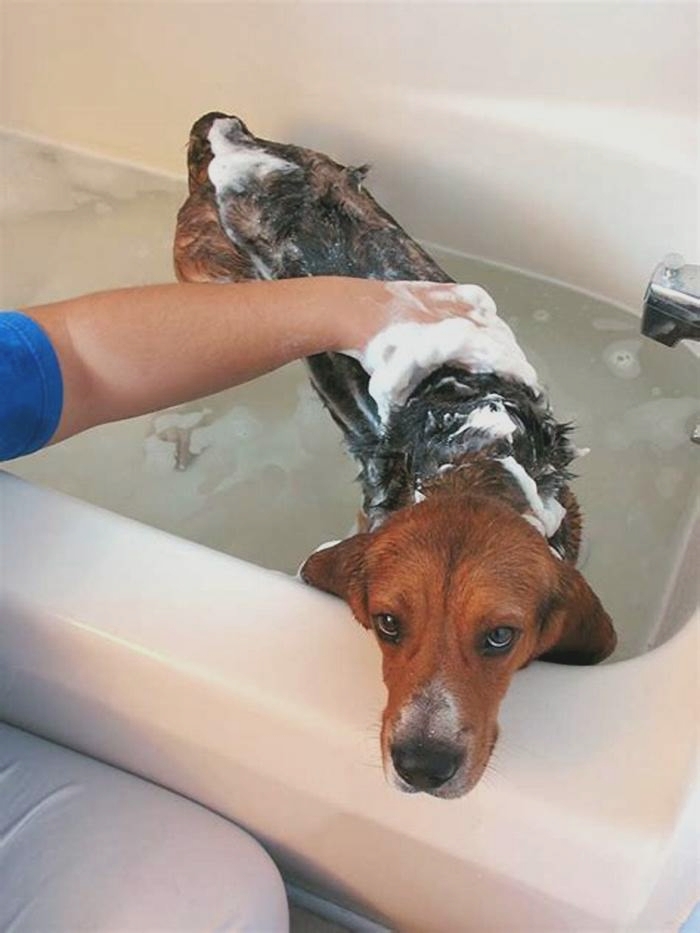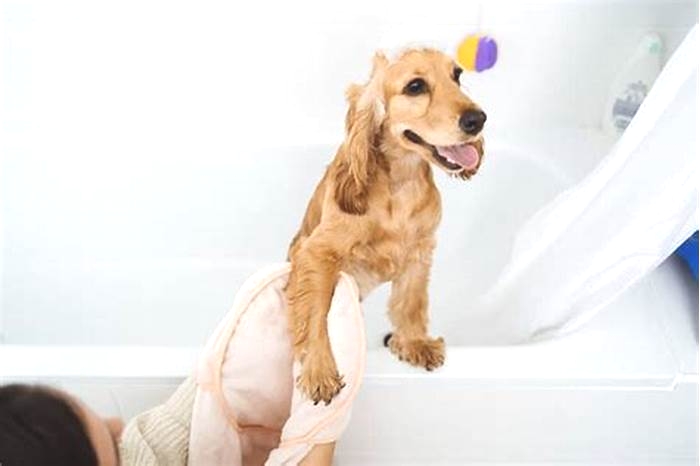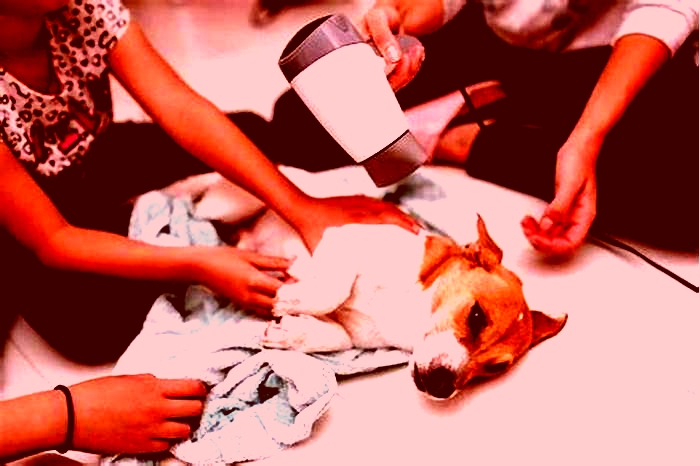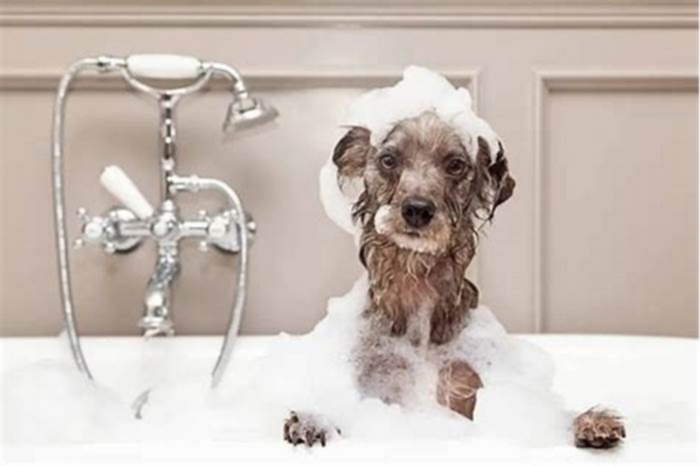Do most dogs hate baths
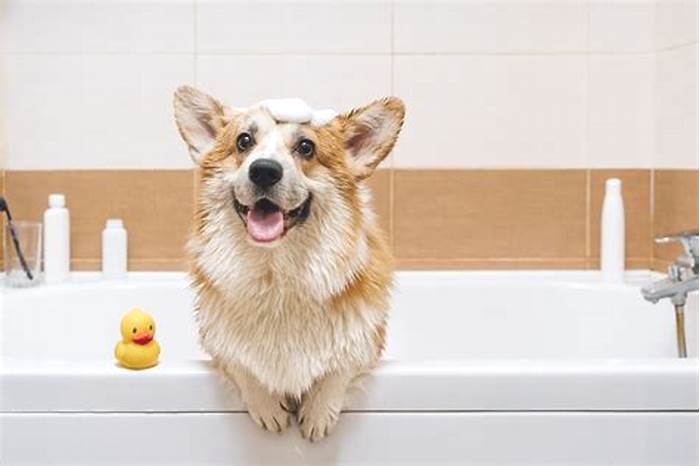
Why Do Dogs Hate Baths? The Traumatic Truth Of Canine Bathtime

Why Do Dogs Hate Baths? Its a running joke among most dog parents that bathtime is an ordeal. Some dogs may run and hide when they hear the dreaded word. Huskies and husky crosses are notorious for mournfully howling a full canine opera when the water hits their fur. Just see this adorable video:
But as cute as this video is, as dog lovers, we are sadly so used to the idea that dogs hate baths that we accept it as normal and even laugh at our dogs clear distress. Often we just think our dogs are dramatic and leave it at that.
Sadly, the truth about why dogs fear bath time is that the experience is often deeply traumatic for most dogs. To get a real understanding of this issue, we need to look at exactly what happens when during a bath from the canine perspective and what we can do to help them.
So, Why Do Dogs Hate Baths?
Most dogs hate baths because the experience is overwhelming and distressing. For many dogs, the bath is a forced situation they cant escape, ambushed with running water and unfamiliar scents even if you use the gentlest and most natural dog shampoo.
In fact, by forcing our dogs to take a bath and ignoring their distress, we are unwittingly making an anxiety-ridden situation so much worse. Even if your dog seems to accept their fate quietly, they still may still be in extreme distress.
Canine physiotherapists Darryl Millis and David Levine outline what we dog owners do that makes even dogs that love water hate baths. It centers around concepts called habituation, flooding, and sensitization. But first, lets look at the problem with how we perceive canine bath phobia.
How We (Unintentionally) Make A Dog Hate Baths
From the very beginning, most of us just put our puppies in a bath and scrub them down, ignoring any signs of distress. We aim to do what Dr. Millis and Dr. Levine call habituate our puppies to water by gently forcing them in. We assume they will get over it.
We dont do this to be cruel, but the issue simply isnt discussed much in the dog world.
Unfortunately, ignoring distress signals causes flooding, where a dog becomes so overwhelmed by the situation that their survival responses kick in. They may turn to fight, flight, or freeze. More on that later.
Flooding means a dog can become more sensitive and reactive to stimulus rather than habituated. This means a puppy traumatized by its first bath can become more resistant as they age. But the major problem seems to be in our attitude to dog bathing vs. other stressful situations where we have far more sympathy with our pups.
How We Fail Our Dogs During Bath Time
If our dogs hide under the furniture during a storm, we usually recognize this as a valid sign of noise phobia or that they are terrified. This will prompt us to find ways to help our dogs cope with their fear and anxiety.
Similarly, suppose our dog struggles on the leash or is extremely distressed in the crate. In that case, we accept that the situation is distressing and (hopefully!) start using positive reinforcement training to make them comfortable gradually.
Yet, when our dogs show the same signs of deep distress over a bath, we often laugh it off as them being four-legged drama queens and force them into it. Even the best professional doggy parlors often have to use some kind of coercion since they are on a schedule and dont have the time to teach every dog that a bath isnt a life-or-death situation.
But our dogs dont know how to be dramatic. If they are signaling fear and distress, they feel fear and distress. This brings us to the next question.
What Do Dogs Think When We Bathe Them?
Do dogs think we are drowning them when we bathe them? Yes and no. Dogs dont have the same concept of being drowned the way we do. But their brains are still flooded with stress signals. This gives them a jolt of stress hormones, and they often think or feel they are in a life-or-death situation.
Consider common reactions to having a bath. Many dogs will run and hide when they suspect they will get a bath. This is a flight survival response.
Dogs like Huskies who howl or vocalize their distress are both trying to tell you they are anxious and using vocalizations to appease you in hopes you will stop. This is the fawn survival response.
Other dogs will engage in an epic battle to escape the tub, leaving you soaking your bathroom in a soggy, sud-filled mess. These are our fighters.
Naturally, you have some poor doggy souls who resign themselves to their fate, tail tucked and shivering, stoically awaiting the end. This is not a sign of a good dog that behaves well in the bath. This is called learned helplessness.
This happens when a dog (or even a human) feels so trapped in their situation that it completely stops trying to escape. This can also be the freeze survival response.
Before we look at how to help our dogs learn to tolerate or even enjoy baths, lets quickly go over why a dog hates baths.

Reasons Why Dogs Dont Like to Bath (Even if They Love Water)
1. They are Restrained
Being restrained in an unfamiliar situation triggers almost every dogs survival response. Think about any time you have seen a feral dog caught on a leash for the first time. Dogs who are chained, muzzled, crated, or restrained in any way without being positively and gradually habituated to the situation, are almost always triggered into a fight or flight response.
Its no different being held in the bath, even by a person they trust. The sensation of being forced to stay still in a strange environment will cause many dogs to react. So being forced to stand still in the tub immediately signals a bad situation to the average dog.
2. Water Becomes a Punishment
Many dogs love water, so long as its on their own terms. Usually, when swimming in a pool, or a lake, chasing a sprayer, or splashing in a muddy puddle, a dog has complete agency over their own body. This means they can trust themselves to swim to safety if they need to.
This is very different from being forced into the water. Holding a dog in place while standing in water or while water rains down on them gives them the sensation of helplessness and even terror. Suddenly, the water is overwhelming and inescapable.
Anybody who uses a spray bottle to discourage their dog from doing something knows very well that forced interaction with water is unpleasant enough to punish even the toughest dog.
The water temperature may also play a role. Hot water or cold water both contribute to the flooding of sensation. The feeling of water rising up their body or raining down on them adds to sensory overload, as does the sound of running water.
3. The Tub is Slippery
While dealing with the overwhelming sensation of being held in place while drenched in water, most dogs also have to deal with a slippery surface. Typically, puppies, in particular, will try to escape the tub and face the feeling of slipping against the side. Older dogs also have to contend with the challenge of keeping their balance.
Not feeling like they have a sure-footing in the bath is just another source of stress for many dogs.
4. The Scent is Unfamiliar
With a nose up to 100 000 times more sensitive than ours, scents quite mild to us are very intense to our dogs. Whats more, we know our dogs love smelly things like socks, so they also have a very different idea of what smells good.
We may love the scent of aloe & oatmeal. Still, being scrubbed down in this unusual, non-doggy scent is another factor adding to the sensory overload already flooding a dogs mind during bath time.
5. They Have Built a Negative Association
Starting from the very first bath they have as puppies, many dogs build a negative association with bath time. Their early experience in the tub is overwhelming and stressful. They are restrained and flooded with the sensation of water, slippery surfaces, and scents they simply learn to associate baths with something negative.
In some cases, this also happens because a dog or puppy is taken to a parlor for the first time and finds the whole experience extremely stressful.
Sometimes a groomer may unwittingly touch an area where a dog is injured or has a painful skin condition, such as one that causes black scabs.
If you love your groomer, you may be curious about how much you should be tipping them.
6. An Emotional Feedback Loop
Another reason dogs become stressed around bath time because their owners are stressed. Dogs are deeply empathetic and good at reading our body language. Some pet parents may become tense when around bath time if they anticipate drama.
Different owners can tackle the issue differently. Some can take a bit of a fighting stance, preparing for the inevitable battle. This can be intimidating for many dogs.
Other pet parents can become upset when their dogs are upset and may even become more distressed than their dogs. A distressed human only gives your dog even more reason to worry.
Either way, a tense owner can cause more tension in their dog, causing the situation to spiral.
7. They Have Never Been Adequately Desensitized to a Bath
Finally, the biggest problem is that we simply dont take the time to teach our dogs that baths are safe and even pleasant. This is odd because we know that we need to teach our puppies nearly everything else, such as how to get along with strangers and other dogs in socialization classes, how to crate, or walk calmly on a leash. Yet, we dont bother to habituate our dogs to the bathing process properly.
So how do we get our dogs to relax around taking a bath?
What To Do When Your Dog Wont Take A Bath
If youre googling my dog hates water but needs a bath or how to a dog a bath that hates baths, the short answer is you dont bathe them. At least not immediately. You first need to desensitize your dog to the bath. However, if you desperately need to clean your dog, you can do the following.
How to Clean a Dog Without Making Them Take a Bath:
- Use a waterless or dry dog shampoo. Simply brush your dog, spray the shampoo on, rub into the skin and fur, and brush it out again.
- Use wet wipes to clean off mud or a dirty spot. You can also use doggy eye wipes to clean the eye area from tears, stains, and boogers. Dont forget to clean the ears as well to prevent infection.
- Brush a cup of baking soda and a cup of cornstarch through your dogs fur. Cornstarch absorbs excess oil and debris, while baking soda deodorizes the coat and kills bacteria. You can also use a special doggy cologne to eliminate unpleasant smells.
Remember this is a temporary measure to keep your dog clean while you teach them to feel comfortable and at ease with a real bath.
Steps To Make Your Dog Love Baths
- Start by feeding your dog daily in the same area you bathe them. If its in the tub, work your dog gradually from having dinner in the bathroom to eating in the bath itself.
- Put a non-slip mat down in the tub so that is never standing on a slippery surface.
- When your dog is happy getting their dinner in the same area they get a bath, you can start to wet the ground or floor of the tub, so they become accustomed to standing in moisture when they eat. Drying their paws off afterward is a great opportunity also to get your puppy comfortable with having their paws handled.
- When your dog has learned that the bathing area is positive and theyre used to wet paws, its time to step it up. Use positive reinforcement to ask your dog to jump in and out of the tub. Lure your dog with a toy or treat (dont forget the non-slip mat, as slipping will discourage them!). Make sure you reward them. Gradually introduce the stay command to ask them to stay in the tub before climbing out again.
- When they are happy standing in the bath or area or area you want to wash them in, introduce the idea of water. If you use a sprayer or hose to wash your dog, turn it on and off for a moment. Do not wet them. Reward them for standing still with water running near them. If you use a container, fill it up and empty it beside them, but on them.
In short, the best way to get your dog to be great with baths is just to break the process down into tiny incremental steps, and gradually make your dog comfortable with each one with a positive association.
It may take longer than wrestling your dog once a month, but it will remove the stress and anxiety from the event, and foster your dogs trust in you.
Frequently Asked Questions (FAQs)
Do dogs get mad when you bathe them?
Some dogs may get mad after a bath. Research suggests that dogs are capable of holding a grudge. However, most dogs are so relieved they survived they get the zoomies. More sensitive dogs may avoid you for a while as they find the experience upsetting and similar to a punishment.
If youre wondering why a dog gets the zoomies after a bath, see our article Why do dogs go crazy after a bath?
Do most dogs hate baths?
Dogs arent born hating baths. Dog owners tend to force their dogs into them without first making the experience a positive one. This makes the sensation of being restrained, drenched, and scrubbed extremely negative, so many dogs learn that baths are bad. Luckily, we can change this.
Why do dogs hate water?
Many dogs, especially water breeds like Poodles and Retrievers, love water. Some breeds are not natural swimmers and are less confident in the water. These dogs need supervision and occasional help learning to swim or gaining confidence in the water. Still, dogs do not hate water unless they have had a negative experience.
Do all dogs hate baths?
All dogs do not hate baths. Whenever a pet parent takes the time to habituate and desensitizes their dog to the bath, baths can become a fun time for dogs and their owners. If we stopped normalizing videos of dogs in distress during a bath, we might have far more footage online of dogs who have truly learned to love their baths, just like in this video:
Final Thoughts
Dogs dont innately hate water or baths. Unfortunately, we as pet owners forget to ensure our dogs positively associate with the cleaning and grooming process to help them enjoy it. Taking the time to make the experience positive for our dogs removes a major common source of fear and anxiety for our dogs.
Meet Your Experts
Tamsin De La Harpe
Author
Tamsin de la Harpe has nearly two decades of experience with dogs in rescue, training, and behavior modification with fearful and aggressive dogs. She has worked closely with veterinarians and various kennels, building up extensive medical knowledge and an understanding of canine health and physiology. She also spent two years in the animal sciences as a canine nutrition researcher, focusing on longevity and holistic healthcare for our four-legged companions.Tamsin currently keeps a busy homestead with an assortment of rescue dogs and three Bullmastiffs.
Tamsin de la Harpe has nearly two decades of experience with dogs in rescue, training, and behavior modification with fearful and aggressive dogs. She has worked closely with veterinarians and various kennels, building up extensive medical knowledge and an understanding of canine health and physiology. She also spent two years in the animal sciences as a canine nutrition researcher, focusing on longevity and holistic healthcare for our four-legged companions.Tamsin currently keeps a busy homestead with an assortment of rescue dogs and three Bullmastiffs.


